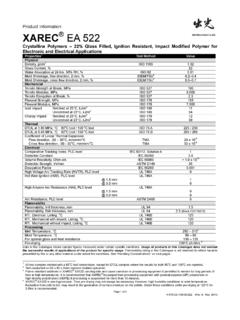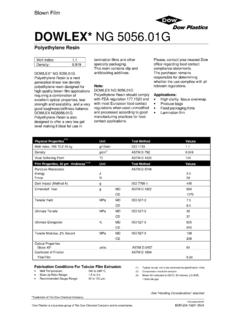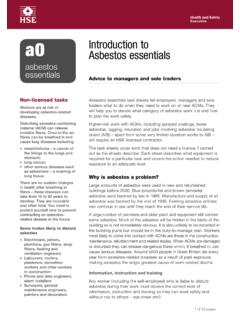Transcription of NatureWorks PLA Polymer 2100D Extrusion/Thermoforming
1 NatureWorks PLA Polymer 2100D Extrusion/Thermoforming NatureWorks PLA Polymer 2100D , a NatureWorks LLC product, is a ther-moplastic resin intended for higher heat applications. Derived primarily from annually renewable resources, it is specifically designed for extru-sion/ thermoforming applications. PLA Polymer 2100D is an opaque extrusion sheet grade and processes easily on conventional extrusion and thermo-forming equipment. See table at right for properties. Applications Potential applications for PLA Polymer 2100D include: Plates and Bowls for hot food ser-viceware Shallow Draw Microwavable Trays Processing Information PLA Polymer 2100D is easily proc-essed on conventional extrusion equipment.
2 The material is stable in the molten state, provided that the drying procedures are followed. Machine Configuration PLA Polymer 2100D will process on conventional extrusion machinery with the following equipment: General pur-pose screw with L/D ratios from 24:1 to 30:1 and compression ratio of :1 to 3:1. Smooth barrels are recommended. Process Details Startup and Shutdown PLA Polymer 2100D is not compatible with a wide variety of polyolefin resins, and special purging sequences should be followed: 1. Clean extruder and bring tempera-tures to steady state with low-viscosity, general-purpose polystyrene or polypropylene.
3 2. Vacuum out hopper system to avoid contamination. 3. Introduce PLA Polymer into the extruder at the operating condi-tions used in Step 1. 4. Once PLA Polymer has purged, reduce barrel temperatures to desired set points. 5. At shutdown, purge machine with high-viscosity polystyrene or polypropylene. Drying In-line drying may be required. A mois-ture content of less than (250 ppm) is recommended to prevent vis-cosity degradation. Typical drying conditions for crystallized granules are 4 hours at 158 F (70 C) or to a dew point of -30 F (-34 C), airflow rate of greater than cfm/lbs per hour of resin throughput.
4 The resin should not exposed to atmospheric conditions after drying. Keep the package sealed until ready to use and promptly reseal any unused material . (1) NatureWorks PLA sheet extrusion Processing Guide is available at Use of Regrind Amorphous regrind may be introduced into the feed stream at levels up to 50% without an adverse effect on ex-truder performance. At levels above 50%, crystallization of the regrind is recommended to prevent screw stick-ing. Processing Temperature Profile (1) Melt Temperature 410 F 210 C Feed Throat 113 F 45 C Feed Temperature 355 F 180 C Compression Section 375 F 190 C Metering Section 390 F 200 C Adapter 390 F 200 C Die 390 F 200 C Screw Speed 20-100 rpm Typical material & Application Properties (1)
5 Physical Properties PLA Polymer 2100D ASTM Method Specific Gravity D792 Melt Index, g/10 min (190 ) 5-15 D1238 Clarity Opaque Mechanical Properties Tensile Strength @ Break, psi (MPa) 8,100 (56) D638 Tensile Yield Strength, psi (MPa) 9,000 (62) D638 Tensile Modulus, kpsi (GPa) 500 ( ) D638 Tensile Elongation, % D638 Notched Izod Impact, ft-lb/in (J/m) ( ) D638 (1) Typical properties; not to be construed as specifications.
6 NatureWorks PLA Polymer 2100D Compostability Composting is a method of waste disposal that allows organic ma-terials to be recycled into a product that can be used as a valuable soil amendment. PLA is made primarily of polylactic acid, a repeating chain of lactic acid, which undergoes a 2-step degra-dation process. First, the moisture and heat in the compost pile attack the PLA Polymer chains and split them apart, cre-ating smaller polymers, and finally, lactic acid. Microorgan-isms in compost and soil consume the smaller Polymer fragments and lactic acid as nu-trients.
7 Since lactic acid is widely found in nature, a large number of organisms metabolize lactic acid. At a minimum, fungi and bacteria are involved in PLA deg-radation. The end result of the process is carbon dioxide, water and also humus, a soil nutrient. This degradation process is tem-perature and humidity dependent. Regulatory guide-lines and standards for composting revolve around four basic criteria: material Character-istics, Biodegradation, Disintegration, and Ecotoxicity. Description of the requirements of these testing can be found in the appropriate geographical area: DIN V 54900-1 (Germany), EN 13432 (EU), ASTM D 6400 (USA), GreenPla (Japan).
8 This grade of NatureWorks PLA meets the requirements of these four standards with limitation of maximum layer thickness of 1650 m and for coating layers up to 37 m Status Status- This is to advise you that on January 3, 2002 FCN 000178 submitted by NatureWorks LLC to FDA became effective. This effective notification is part of list currently maintained on FDA s website at ~ This grade of NatureWorks PLA may there-fore be used in food packaging materials and, as such, is a per-mitted component of such materials pursuant to section 201(s) of the Federal, Drug, and Cosmetic Act, and Parts 182, 184, and 186 of the Food Addi-tive Regulations.
9 All additives and adjuncts contained in the referenced NatureWorks PLA formulation meet the applicable sections of the Federal Food, Drug, and Cosmetic Act. The finished Polymer is approved for all food types and B-H use condi-tions. We urge all of our customers to perform GMP (Good Manufacturing Proce-dures) when constructing a package so that it is suitable for the end use. Again, for any ap-plication, should you need further clarification, please do not hesi-tate to contact NatureWorks LLC. European Status- This grade of NatureWorks PLA complies with EU Plastics Direc-tive 2002/72/EC, which applies to all EU member states.
10 The Plas-tics Directive is a consolidated version of the Monomers Direc-tive (Commission Directive 90/128/EEC) and its first 7 amendments. This grade of NatureWorks PLA is also in compliance with "Bedarfgegen-st nde Gesetz", which is the German implementation of the EU Plastics Directive 2002/72/EC. Substances used in the manufacturing of this product which are not yet regulated by EU Plastics Directive 2002/72/EC, as amended, are in compliance with appropriate EU national regulations. Nature-Works LLC would like to draw your attention to the fact that the EU-Directive 2002/72/EC, which applies to all EU-Member States, includes a limit of 10 mg/dm2 of the overall migration from fin-ished plastic articles into food.







